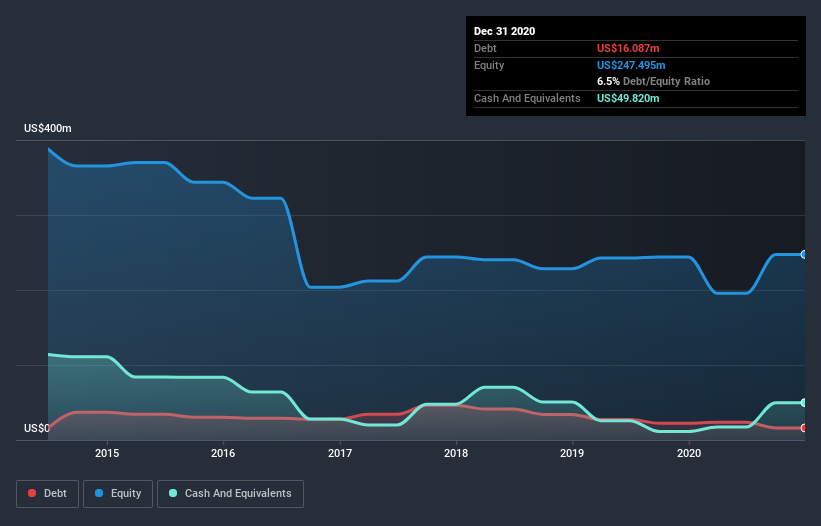Is Gem Diamonds (LON:GEMD) Using Too Much Debt?
David Iben put it well when he said, 'Volatility is not a risk we care about. What we care about is avoiding the permanent loss of capital.' It's only natural to consider a company's balance sheet when you examine how risky it is, since debt is often involved when a business collapses. Importantly, Gem Diamonds Limited (LON:GEMD) does carry debt. But is this debt a concern to shareholders?
When Is Debt A Problem?
Debt assists a business until the business has trouble paying it off, either with new capital or with free cash flow. Part and parcel of capitalism is the process of 'creative destruction' where failed businesses are mercilessly liquidated by their bankers. However, a more common (but still painful) scenario is that it has to raise new equity capital at a low price, thus permanently diluting shareholders. Of course, plenty of companies use debt to fund growth, without any negative consequences. When we examine debt levels, we first consider both cash and debt levels, together.
Check out our latest analysis for Gem Diamonds
How Much Debt Does Gem Diamonds Carry?
The image below, which you can click on for greater detail, shows that Gem Diamonds had debt of US$16.1m at the end of December 2020, a reduction from US$22.3m over a year. But on the other hand it also has US$49.8m in cash, leading to a US$33.7m net cash position.
A Look At Gem Diamonds' Liabilities
According to the last reported balance sheet, Gem Diamonds had liabilities of US$61.2m due within 12 months, and liabilities of US$105.5m due beyond 12 months. Offsetting these obligations, it had cash of US$49.8m as well as receivables valued at US$4.44m due within 12 months. So its liabilities total US$112.4m more than the combination of its cash and short-term receivables.
This is a mountain of leverage relative to its market capitalization of US$138.1m. Should its lenders demand that it shore up the balance sheet, shareholders would likely face severe dilution. While it does have liabilities worth noting, Gem Diamonds also has more cash than debt, so we're pretty confident it can manage its debt safely.
In addition to that, we're happy to report that Gem Diamonds has boosted its EBIT by 90%, thus reducing the spectre of future debt repayments. The balance sheet is clearly the area to focus on when you are analysing debt. But ultimately the future profitability of the business will decide if Gem Diamonds can strengthen its balance sheet over time. So if you want to see what the professionals think, you might find this free report on analyst profit forecasts to be interesting.
Finally, while the tax-man may adore accounting profits, lenders only accept cold hard cash. Gem Diamonds may have net cash on the balance sheet, but it is still interesting to look at how well the business converts its earnings before interest and tax (EBIT) to free cash flow, because that will influence both its need for, and its capacity to manage debt. Looking at the most recent three years, Gem Diamonds recorded free cash flow of 38% of its EBIT, which is weaker than we'd expect. That weak cash conversion makes it more difficult to handle indebtedness.
Summing up
Although Gem Diamonds's balance sheet isn't particularly strong, due to the total liabilities, it is clearly positive to see that it has net cash of US$33.7m. And it impressed us with its EBIT growth of 90% over the last year. So we don't have any problem with Gem Diamonds's use of debt. The balance sheet is clearly the area to focus on when you are analysing debt. However, not all investment risk resides within the balance sheet - far from it. These risks can be hard to spot. Every company has them, and we've spotted 3 warning signs for Gem Diamonds (of which 1 shouldn't be ignored!) you should know about.
If you're interested in investing in businesses that can grow profits without the burden of debt, then check out this free list of growing businesses that have net cash on the balance sheet.
This article by Simply Wall St is general in nature. It does not constitute a recommendation to buy or sell any stock, and does not take account of your objectives, or your financial situation. We aim to bring you long-term focused analysis driven by fundamental data. Note that our analysis may not factor in the latest price-sensitive company announcements or qualitative material. Simply Wall St has no position in any stocks mentioned.
Have feedback on this article? Concerned about the content? Get in touch with us directly. Alternatively, email editorial-team (at) simplywallst.com.

